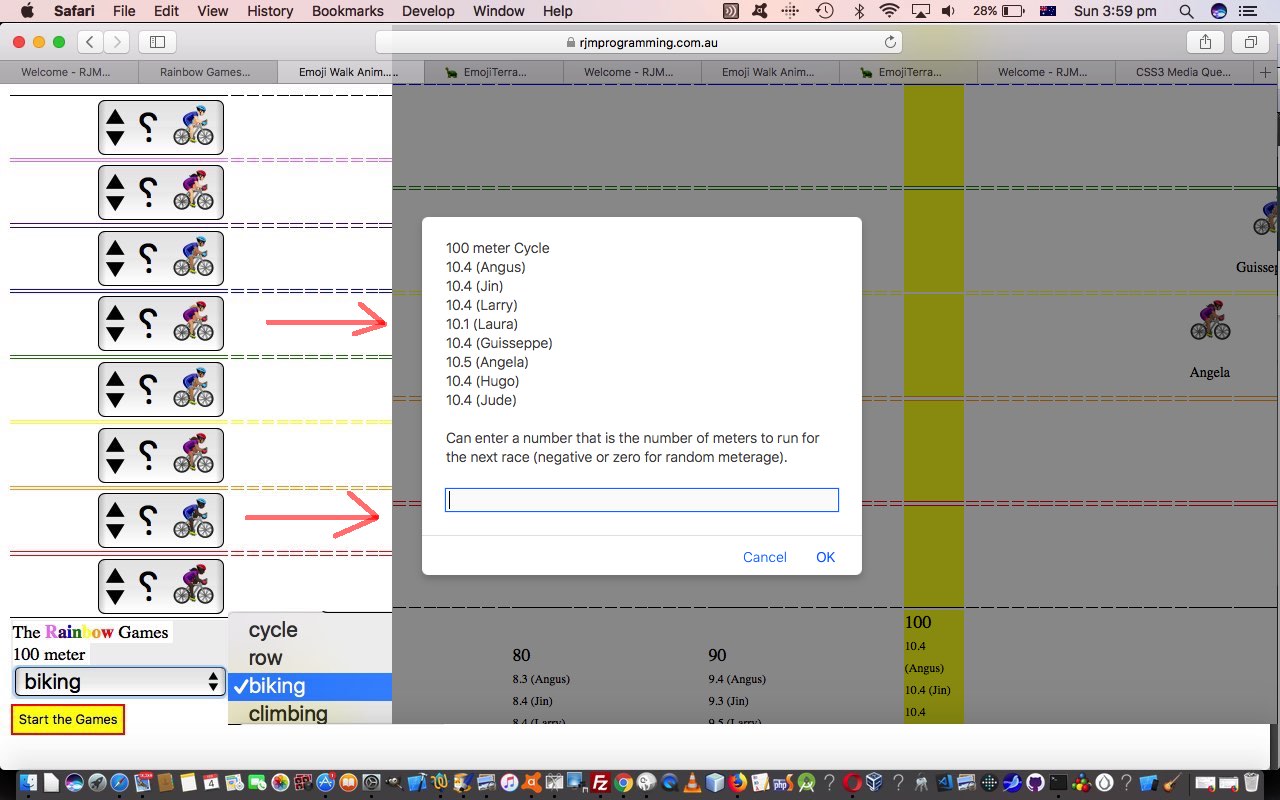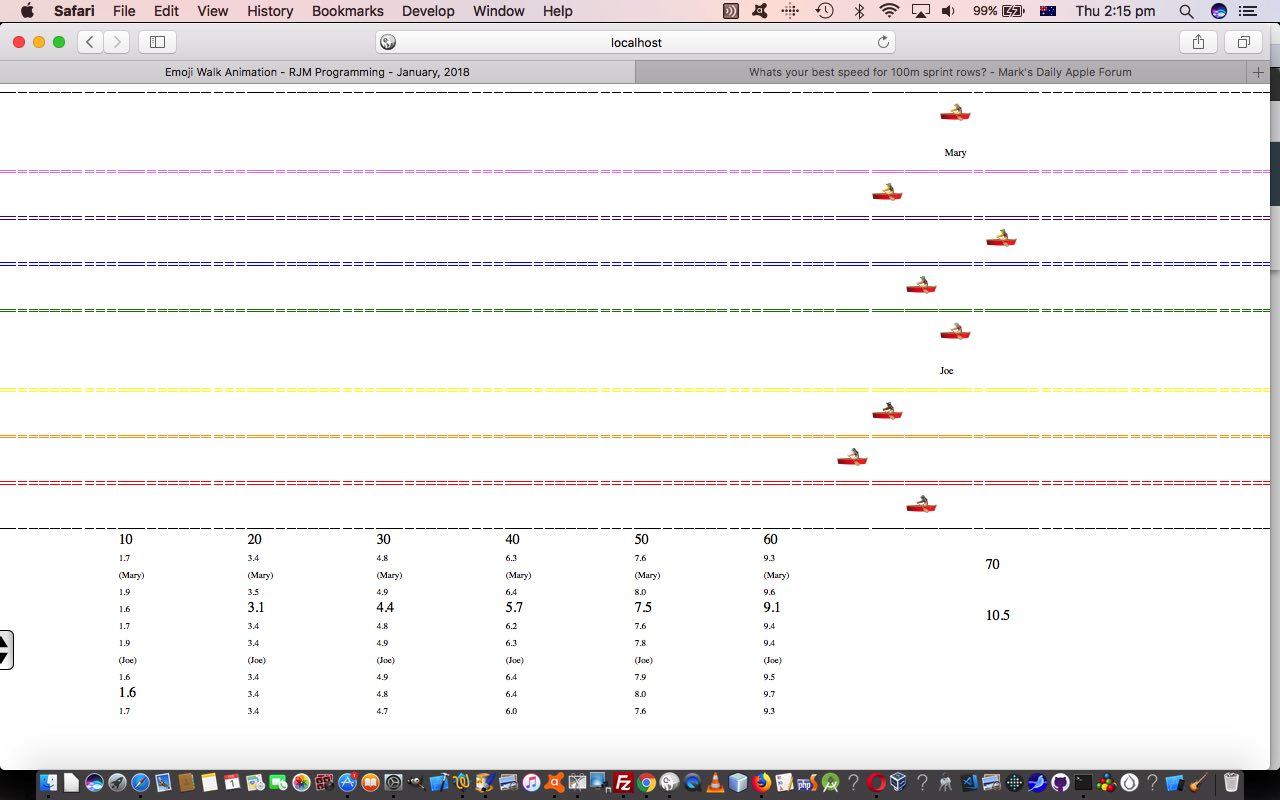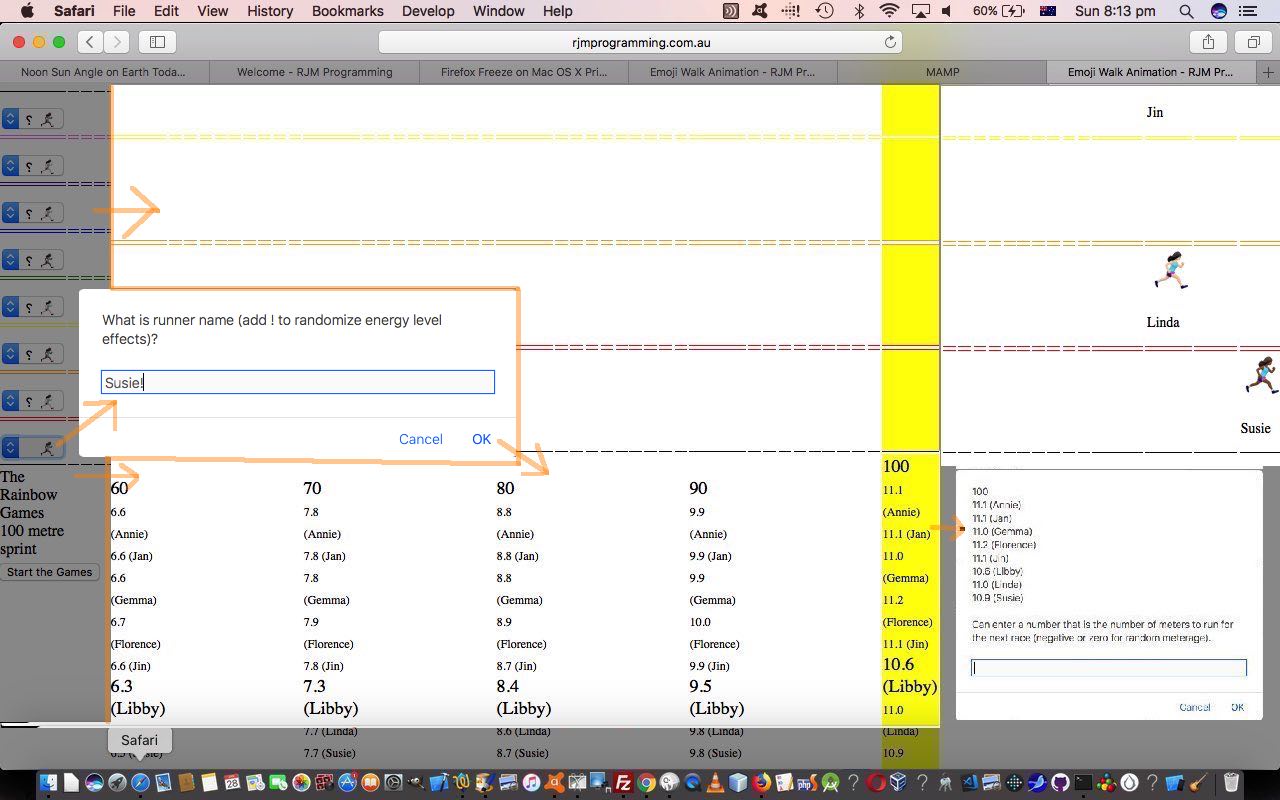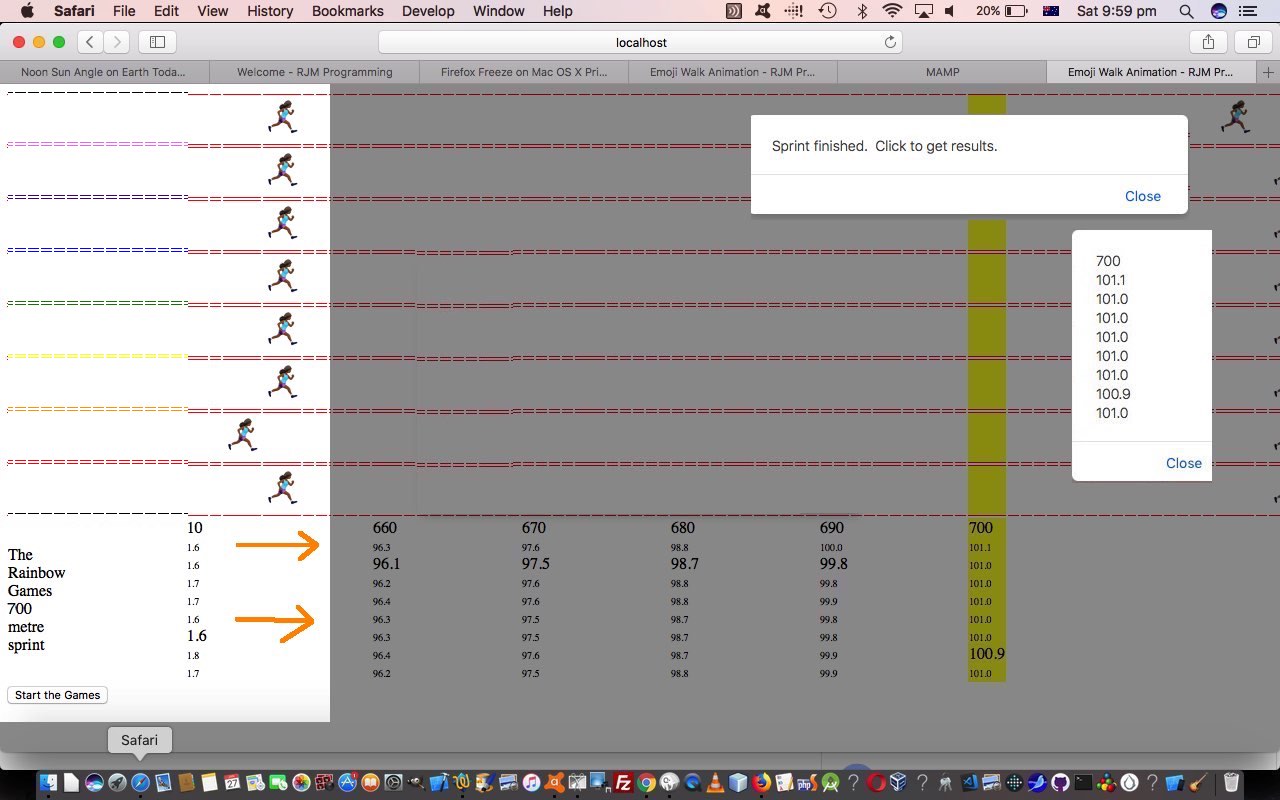We got quite excited recently with Rainbow Games PHP Emoji Tutorial when we added a (fourth Beatle) emoji helper, called Emoji Terra, into the mix of tools to gather emoji information. Today, we’ve got a new Emoji Search web application that introduces a new (fifth Beatle(?)) emoji helper tool to add into the “how we see it” mix below …
- Emojipedia is good for looking up Emoji names or concepts in words
- FileFormat Information is great for HTML Entity determinations for your less complex Emojis
- Iemoji is great for HTML Entity determinations for Emojis of all complexities
- Emoji Terra performs similar functionality as Iemoji but has a permalink organization more friendly to an “emoji search via emoji title” query, and that has suited our purposes today, and before, so, thanks a lot
- Emoji CSS performs similar functionality to Emojipedia, but has a pictorial view of Emoji names as well, right from the word go, thanks
With these emoji tools in mind we wrote a new PHP web application combining those last two to show Emojis pictorially (with their short name) initially and allow the user to search for an Emoji (match) list via their HTML input type=text (textbox) entry, which results in …
- the Emoji (match) list look (as an Emoji “display”) … and …
- an HTML a link which is that Emoji’s short name … linking to …
- an Emoji Terra webpage with more detail, including HTML Entity information if “short name” is unique, or one extra click away, if not
Maybe you need to try the live run and/or its PHP source code emoticon_keyboard_shortcuts.php to download, perhaps?
Previous relevant Rainbow Games PHP Emoji Tutorial is shown below.
In order to take that further genericization step onto the achievements of yesterday’s Rainbow Games Genericization Tutorial to get onto (the mathematics Induction principle inspired) …
- prove for the first case
- prove for the second case
- prove for the nth case
… we had a choice of …
- continue on (with) the HTML code creation of new “hardcoded” arrays (managed by Javascript eval abstractional approach) … or “bite the bullet” and …
- try to work out a generic “emoji lookerer upperer” arrangement
Guess you can tell we opted for the latter, huh?! We started the investigation of this by examining our three favourite emoji informational websites, namely …
… and were a bit surprised that we could not quite swing a generic method to glean the information, so don’t know whether our new “player” is “Ringo Starr” or not, but can tell you this, “its beat is much better than its bite” … chortle, chortle …
Emoji Terra performs similar functionality as Iemoji but has a permalink organization more friendly to an “emoji search via emoji title” query, and that suits our purposes today, so, thanks a lot. Without this query by “emoji title” possibility we’d have been forced to adopt more of those “hardcoded” arrays, which would have been alright, but this second approach opens the door to “sport” events in “The Rainbow Games” web application using emojis of the future (ie. they haven’t been invented yet).
How to work the interfacing to Emoji Terra?
- good ol’ PHP serverside language
- good ol’ PHP’s file_get_contents (supplemented by)
- good newish “PHP Source File as the Database Source” we’ve talked about in the past with PHP Require Database Primer Tutorial and Signature Signature PHP Tutorial whereby the PHP Source File updates itself with web application data
This new PHP emoji_lookup.php treats the “prove for the nth case” sports as ones to …
- look up the emoji information for (in the order “PHP Source File as the Database Source” then try file_get_contents of Emoji Terra lookup), and …
- read the HTML partner source code live run‘s underlying HTML and Javascript and CSS emoji_walk_animation.htm (which changed in this way)
- amend that HTML source to supplant the “Sprint” default sport for this new nominated sport … trying not to fall over laughing at some of the new sports we present (inspired by a visit to Emoji Terra search)
- write out that amended HTML code as the web page (the beauty of a serverside language like PHP)
The more detailed specifics of the file_get_contents of Emoji Terra lookup above are …
- build up a URL starting with HTTP://emojiterra.com/ … then …
- in emojiland arrangements there are two genders (as our prefixes if you will) … woman- and man-
- then add on a “middle” sport descriptor (eg. biking)
- in emojiland emoticonland arrangements there are five descriptors (as our suffixes if you will) … -dark-skin-tone, -medium-dark-skin-tone, -medium-skin-tone, -medium-light-skin-tone, -light-skin-tone
- for that set of 2x1x5=10 URLs glean what “HTML dec” (HTML Entity) information you can glean via the file_get_contents call of the Emoji Terra URLs described above (eg. Emoji: Woman Biking: Dark Skin Tone) … built into a Javascript array string to “plug into” the previously read HTML partner source code, and amended to output as the web page the user sees
Sports of the future in emojiland? Just ask for the equivalent of biking (above) off the user via a Javascript prompt window (on the proviso you read Conditional Alternative to Javascript Popup Windows in iOS Tutorial first please).
Previous relevant Rainbow Games Genericization Tutorial is shown below.
What would help genericize the recent Rainbow Games Double Transformation Tutorial “Rainbow Games” web application? How about introducing another sport?
Again, in honour of “onions of the 4th dimension” approaches, we mainly, turn to the power of Javascript’s eval methodology to achieve this abstracted feeling to our web application. Today, with this, we go two thirds of the way along the “Mathematical Induction” approach …
- prove for the first case
- prove for the second case
- prove for the nth case
How does this use of Javascript eval manifest itself in this way?
- there are two arrays that work with the “content” of our “Rainbow Games” sport(s) (well, at least, the first “sprint running” sport) called emoticons[] and choices[]
- wherever we find references in the code to either of these two arrays we start to involve the global variable verbsuffix …
var verb='Sprint';
var verbs=['Sprint','Row'];
var anotherverb='run';
var verbsuffix='';
… in altered ways like …
function plus(ih,ihep) {
var outihep=ihep;
if (eval("emoticons" + verbsuffix + "[" + ih + "]").indexOf('<p>') != -1) {
outihep += ' (' + eval("emoticons" + verbsuffix + "[" + ih + "]").split('<p>')[1].split('<')[0] + ')';
}
return outihep;
}
… in that abstracted way … noting that sometimes you don’t need the “eval()” encasings … - and so, working through the code this way it just falls to the coder to define new members for all the arrays for all the new sports (ours is “rowing” today), some of those new arrays (like for rowing are emoticonsrowing[] and choicesrowing[]) to involve …
- looking up emoji definitions from …
… not forgetting to …
- make sure the event logics work for multiple sport scenarios … but mostly they do by sticking to the principles above … especially for the …
- new HTML select (dropdown) element allows the user to pick a sport
Remaining a work in progress, you can try out our live run link that has underlying HTML and Javascript and CSS emoji_walk_animation.htm, and which changed in this way regarding today’s genericization work. We hope it gives you food for thought.
Previous relevant Rainbow Games Double Transformation Tutorial is shown below.
We were on the “road to personalization” for the web application game we started with yesterday’s Rainbow Games Primer Tutorial when “an old chestnut” came up again. It’s happened before, the desire to “double transform” in CSS came about from our emoji …
| 🏃🏾♀️ |
… table cell mirroring styling as per …
<style>
* { overflow-x: visible; }
select { font-size: 36px; }
td.runner { width: 50px; word-wrap: break-word; font-size: 36px;
transform: scale(-1, 1); -o-transform: scale(-1, 1); -moz-transform: scale(-1, 1); -ms-transform: scale(-1, 1); -webkit-transform: scale(-1, 1);
} //
| 🏃🏾♀️ |
tr { max-height: 40px; }
</style>
… necessary to make our running emojis run from left to right (that, alas, also transformed any accompanying …
| 🏃🏾♀️
Florence |
… name), was added to in this double transformational clause to prove what this wonderful web page advice had to say. In other words, a “double transform” CSS styling scenario like the one below …
<style>
* { overflow-x: visible; }
select { font-size: 36px; }
td.runner { width: 50px; word-wrap: break-word; font-size: 36px;
transform: scale(-1, 1); -o-transform: scale(-1, 1); -moz-transform: scale(-1, 1); -ms-transform: scale(-1, 1); -webkit-transform: scale(-1, 1);
}
tr { max-height: 40px; }
p {
display: block;
font-size: 12px;
-webkit-transform: matrix(-1, 0, 0, 1, 0, 0);
-moz-transform: matrix(-1, 0, 0, 1, 0, 0);
-o-transform: matrix(-1, 0, 0, 1, 0, 0);
transform: matrix(-1, 0, 0, 1, 0, 0);
} //
| 🏃🏾♀️
Florence |
</style>
… works as a “double transform” to first …
- mirror (image) flip the table cell (td) emoji data … but us appending some “Runner Name” textual data underneath also, annoyingly, got flipped until …
- within that (same) table cell (td) element and after the emoji data we append an HTML p(aragraph) element to both …
- introduce a new HTML element type into the (CSS styling) mix … and to …
- introduce a new CSS transformation type, the matrix … perhaps either or both new parts to the problem critical to its success when, believe me, lots of other approaches don’t work
… to personalize the “runners” and “users”, optionally, “into the game”, by allowing the “user” to name their “runners” and allow for a “runner energy” setting be a bit randomized, to add for some other interest “variety” to the game’s workings. So, still a work in progress that you can try out at our live run link that has underlying HTML and Javascript and CSS emoji_walk_animation.html, and which changed in this way regarding today’s work.
Previous relevant Rainbow Games Primer Tutorial is shown below.
It’s been a while since we’ve written any conventional HTML and Javascript and CSS game. Today’s game uses the “emoticon” section of the Emoji character set, defaulting so far, to the “running woman” emoji featuring in Compound Emoji WordPress Usage Tutorial.
It’s the early days of our “Rainbow Games” web application, and we’re starting with the animation featuring horizontal hashtag navigation techniques for a running race start to our game. Where it finishes? Hard to say! Today, we’ve looked at “splits” and a finish line.
You can try out our burgeoning live run game concept link that has underlying HTML and Javascript and CSS emoji_walk_animation.html.
If this was interesting you may be interested in this too.
If this was interesting you may be interested in this too.
If this was interesting you may be interested in this too.
If this was interesting you may be interested in this too.
If this was interesting you may be interested in this too.







One Response to Emoji Name Search Primer Tutorial